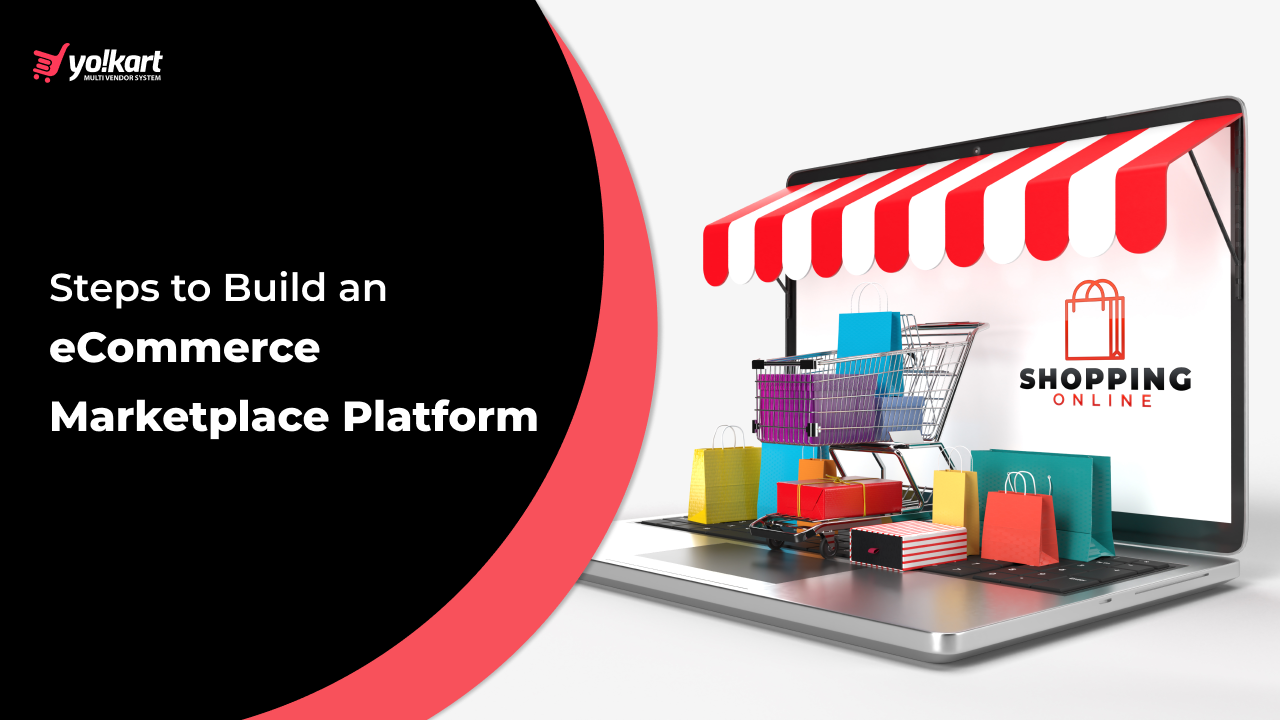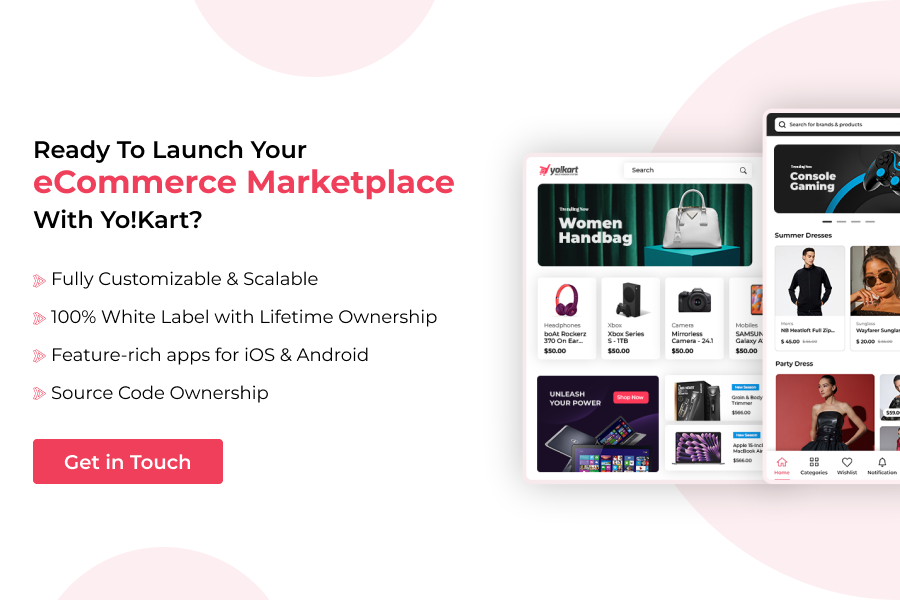In the relentless pursuit of digital dominance, the allure of the eCommerce marketplace platform continues to rise, promising a path for scalable growth and diversified revenue streams. With the eCommerce market size estimated at $4.32 trillion in 2025 and projected to grow at a CAGR of 8.02% over the period of 2025-2029, building your own eCommerce marketplace platform presents a lucrative business opportunity.
Yet, the path from concept to a thriving eCommerce marketplace platform requires a strategic approach that balances technology, operations, and user experiences. Success lies in creating a marketplace that not only connects buyers and sellers but also delivers a seamless user experience, fosters trust, and scales effortlessly.
Therefore, this blog outlines the seven fundamental steps to help you build a robust, high-performing eCommerce marketplace platform, equipping you with actionable insights necessary to navigate this intricate landscape.
Table of Contents
What is an eCommerce Marketplace Platform?
An eCommerce marketplace platform is a digital ecosystem where multiple vendors can list, sell, and manage their products or services, while customers can browse, compare, and purchase from various sellers.
Compared to traditional eCommerce stores, where a single business sells its own products, an eCommerce marketplace platform allows several third-party vendors to sell their offerings. The platform owner typically acts as an intermediary, managing key operations such as payment processing, logistics, customer service, and platform security. eCommerce marketplace platforms have gained immense popularity due to their scalability, convenience, and ability to serve a broad audience. They provide businesses with a readymade infrastructure to reach customers without investing heavily in website development, marketing, and fulfillment. Whereas on the other hand, customers benefit from diverse product selection, competitive pricing, and a streamlined shopping experience.
Successful eCommerce marketplaces like Amazon, eBay, Alibaba, and Etsy have revolutionized online shopping by offering a frictionless buying and selling experience. Amazon is a prime example of a global eCommerce marketplace platform. It operates as a B2C, B2B, and C2C platform, allowing third-party sellers to list their products alongside Amazon’s inventory. The company provides infrastructure for logistics, payment processing, and customer service, earning revenue through commissions, fulfillment services, and advertising.
Types of eCommerce Marketplace Platforms
eCommerce marketplace platforms can be classified based on their business model, target audience, and offerings. Understanding these distinctions is essential for businesses looking to build an eCommerce marketplace platform tailored to their objectives. Here are some of the common eCommerce marketplace platform types:
1. Based on Business Model:
- Business-to-Business (B2B) Marketplaces: These platforms connect manufacturers, wholesalers, and distributors with retailers or other businesses. Transactions typically involve bulk orders, longer sales cycles, and negotiations. Examples include Alibaba, IndiaMART, and ThomasNet.
- Business-to-Consumer (B2C) Marketplaces: These platforms enable businesses to sell directly to individual consumers. They often focus on providing a seamless shopping experience with competitive pricing, fast shipping, and extensive customer support. For example, Amazon, Walmart Marketplace, and Zalando.
- Consumer-to-Consumer (C2C) Marketplaces: These platforms allow individuals to buy and sell products or services directly to other consumers. They typically operate on a peer-to-peer model, with the platform earning revenue through transaction fees or premium listings. For instance, eBay, Poshmark, and Facebook Marketplace.
2. Based on Target Audience:
- Horizontal Marketplaces: These platforms cater to a broad audience by offering diverse product categories across various industries. They are designed for mass-market appeal, providing customers with an extensive selection of products—for instance, Amazon, eBay, and Flipkart.
- Vertical Marketplaces: These marketplaces specialize in a specific niche, providing a more curated shopping experience with highly targeted offerings. Such eCommerce marketplace platforms often attract passionate customer bases and industry-specific sellers. Examples include Farfetch, StockX, GNC, and Envato.
3. Based on Offerings:
- Products-based Marketplaces: These platforms focus on selling physical or digital products, with vendors managing inventory and logistics or leveraging platform-provided fulfillment services. For example, Etsy and Newegg.
- Service-based Marketplaces: Instead of selling physical products, these eCommerce marketplace platforms connect consumers with service providers in various industries, such as freelancing, home services, tutoring, or professional consulting. Popular examples include Fiverr, Upwork, UrbanClap, and Udemy.
Keen to Launch an eCommerce Marketplace Platform with a Unique Business Model?
How Does an eCommerce Marketplace Platform Work?
An eCommerce marketplace platform is an asset-light business model designed for scalability and efficiency, requiring less substantial investment. Instead of managing inventory, the platform serves as an intermediary between buyers and sellers while earning revenue through commissions on transactions, eliminating inventory risks and operational complexities.
Here’s how an eCommerce marketplace platform works:
1. Sellers register themselves on the platform, create their profiles, and list their products or services with detailed descriptions and clear images.
2. Buyers explore the marketplace, compare different offerings, and make informed purchasing decisions.
3. Customers add selected items to the cart, proceed to checkout, and complete the payment process.
4. Once an order is placed, sellers prepare the products and hand them over to a logistics partner for fulfillment.
5. The logistics partner ensures safe and timely delivery to the buyer, enhancing the overall shopping experience.
6. Buyers can leave their reviews and ratings about their experience, fostering trust and improving marketplace credibility.
7. The platform then earns a commission on each transaction before transferring the remaining amount to the seller.
This technology-driven business model optimizes operations, minimizes overhead costs, and enhances both seller and buyer experiences, making it a highly sustainable and profitable approach to modern eCommerce.
Essential Steps to Build an eCommerce Marketplace Platform
Building a thriving eCommerce marketplace platform requires a deep understanding of market dynamics and a structured business plan that drives sustainable revenue growth while ensuring a seamless user experience.
Here’s a step-by-step breakdown of the crucial phases involved in building a scalable and competitive eCommerce marketplace platform:
Step 1. Conduct Thorough Market Research
Thorough market research lays the foundation for a successful eCommerce marketplace platform. It involves analyzing industry trends, studying competitor strategies, and understanding customer behavior. Other than that, you can consider leveraging data analytics, surveys, and industry reports to gain insights into:
- Emerging market trends and consumer preferences.
- Competitive strengths and weaknesses of existing players.
- Pricing strategies and business models that drive revenue.
- Regulatory and compliance requirements for eCommerce operations.
The primary goal should be to identify market demands, potential challenges, and opportunities that will shape your marketplace’s unique value proposition.
Step 2. Identify Gaps in the Industry
A successful eCommerce marketplace platform distinguishes itself by addressing unmet needs within the industry. Businesses must identify inefficiencies, underserved segments, or potential innovations that can enhance user experience. Leveraging market research data and engaging with potential users can reveal pain points that competitors overlook, allowing the marketplace to carve a unique space in the industry.
Whether it’s introducing a niche product category, introducing innovative features, streamlining logistics and payments, providing enhanced on-demand services, or offering improved seller support with reduced commissions—filling such gaps can differentiate your service offerings and create a competitive advantage.
This is how your marketplace can deliver an innovative, differentiated offering that attracts both buyers and sellers.
Build an eCommerce Marketplace Platform with a Unique Value Proposition
Step 3. Strategize Your Business Model
Choosing the right business model for your eCommerce marketplace platform will help you define how your website will generate revenue and sustain growth. Common models include:
- Commissions: Deducting a percentage from each transaction.
- Advertising: Earning a significant amount from third-party ad placements.
- Partnerships: Partnering with businesses for enhanced user attraction and promotions.
- Subscription Plans: Providing membership plans for exclusive benefits and ensuring steady income flow.
- Listing Fees: Sellers are charged a fee to list products or services on the platform.
- Featured Recommendations: Charging sellers for displaying their products in the highlighted sections.
- Value-Added Services: Providing additional services, such as same-day delivery, one-day delivery, etc, for additional charges.
Defining the marketplace’s revenue streams, pricing strategies, and monetization plans will, thus, ensure financial stability while attracting both sellers and buyers. This will not only help in long-term sustainability but also help maximize growth for your business.
Step 4. List Down Essential Features
A well-functioning eCommerce marketplace platform relies on the features that enhance its user experience, security, and operational efficiency. Defining these features early in the development phases ensures that the platforms meet the expectations of both the seller and the buyer. Some critical features include:
- Vendor Onboarding & Management: A seamless registration process for sellers with an intuitive dashboard to manage orders, inventory, and customer interactions.
- Intuitive User Interface: A clean, visually appealing, and easy-to-navigate user interface that enhances product discovery and purchasing convenience.
- Inventory Management: Automated inventory tracking, stock level notifications, and low-stock alerts to prevent overselling or stockouts.
- Advanced Search Module: Advanced search filters, auto-suggestions, and category-based navigation for enhanced product discovery.
- Easy Checkout Process: A seamless and secure checkout experience with minimal steps, guest checkout options, and auto-filled information.
- Order Tracking & Logistics Integration: Real-time order tracking and integration with shipping providers for smooth logistics management.
- Product Reviews & Ratings: Authentic customer reviews in order to build trust and credibility for both buyers and sellers.
- Secure Payment Gateways: Multiple payment options, including credit/debit cards, digital wallets, and cash, with built-in fraud detection mechanisms.
- Refund/Return Management: A streamlined process for handling refunds and returns, ensuring hassle-free resolutions for buyers and sellers.
- Admin Dashboard: Oversee and manage user actions on the platform with the robust admin dashboard.
- Cart Abandonment Alerts: Automated reminders for users who leave items in their carts to improve conversion rates.
- Robust Reporting & Analytics: In-depth reports on sales trends, customer preferences, and operational efficiency to optimize business performance.
- Chat & Customer Support: AI-powered chatbots and live customer support to assist users in real time.
Additional advanced features, such as multi-currency support, localization for international markets, and marketing automation tools, can further enhance marketplace functionality. Prioritizing features based on user needs ensures an engaging and efficient eCommerce marketplace platform.
Launch a Feature-Rich eCommerce Marketplace Platform
Step 5. Choose Between the Development Approaches
Selecting the right development approach for your eCommerce marketplace platform plays a significant role in determining how quickly and efficiently your platform can be launched. There are primarily two development approaches present in the market: Custom Development and Readymade Software, both of which offer distinct advantages and considerations. Let’s now understand each in brief:
- Custom Development: This approach involves custom building an eCommerce marketplace platform completely from scratch. It offers complete flexibility over features, branding, and customizability. However, custom building an app requires significant investment in terms of time, money, and technical expertise.
- Readymade Software: Readymade eCommerce marketplace software solutions are pre-built scripts used to build and launch eCommerce marketplace platforms quickly and cost-effectively. Equipped with essential features and functionalities, they do not require hefty investments to integrate features one by one. Moreover, many software solutions now offer scalability and customizability options, keeping in mind the requirements of eCommerce businesses for unique branding and long-term growth.
Although, the right approach depends on several factors such as budget, time-to-market goals, and long-term scalability needs, howsoever, choosing a readymade software solution for your eCommerce marketplace platform is a modern and optimal choice. This is because they do not require a hefty amount of investment and can quickly build your eCommerce marketplace platform, ensuring faster market entry.
Step 6. Launch the Marketplace
Once your eCommerce marketplace platform is fully developed, a strategic launch with careful planning and execution is essential for gaining traction. A successful launch requires rigorous testing, refining the UI/UX, and optimizing performance. Before going live, conducting load testing will help identify potential glitches and ensure that the platform can handle high traffic without downtime. A phased launch strategy, starting with a soft launch for early adopters, can generate initial feedback for improvements. Ensuring seamless payment processing, secure transactions, and compliance with legal regulations is crucial before launching the marketplace. Apart from this, the launch strategy should be accompanied by promotional campaigns to generate buzz and attract both sellers and buyers.
Step 7. Implement Well-Thought-Out Marketing Strategy
Building an eCommerce marketplace platform is just a beginning; continuous growth requires an effective marketing strategy. A combination of digital marketing tactics, community engagement, and vendor partnerships can drive traffic and user engagement.
Some effective strategies include:
- SEO and Content Marketing: Optimizing product listings and blog content to improve search engine rankings and attract organic traffic.
- Social Media Advertising: Running targeted campaigns on various platforms like Facebook, Instagram, and LinkedIn to reach potential buyers and sellers.
- Influencer & Affiliate Marketing: Partnering with industry influencers and affiliates to boost credibility and referrals.
- Referral & Loyalty Programs: Encouraging existing users to refer new customers through incentives such as discounts and cashback.
- Email & Retargeting Campaigns: Sending personalized recommendations and abandoned cart reminders to re-engage users.
Consistently analyzing marketing performance, gathering user feedback, and optimizing strategies ensures long-term marketplace success. By focusing on user acquisition and retention, businesses can establish a strong brand presence and achieve sustained growth.
How Does Yo!Kart Help?
Building a successful eCommerce marketplace platform demands sophisticated, scalable, and feature-rich eCommerce software that streamlines business operations while delivering seamless user experience. Yo!Kart is one such purpose-built, multi-vendor eCommerce marketplace software designed to empower businesses to build robust eCommerce marketplace platforms across diverse niches. Here’s how Yo!Kart empowers businesses in establishing a high-performing eCommerce marketplace platform:
- White-Label Solution: Businesses can rebrand the platform efficiently, reflecting their unique brand identity.
- Self-hosted Software: The software offers complete flexibility to either host the server on-premise or some third-party server.
- Feature-Rich Software: Yo!Kart is built with a comprehensive set of features essential for running a competitive eCommerce marketplace platform.
- Fully Customizable and Scalable Solution: It provides a highly flexible and scalable architecture, ensuring that businesses tailor their eCommerce marketplace platform to meet their unique requirements.
- Secure & Scalable Tech Stack: Yo!Kart is designed with robust security protocols, including SSL encryption and GDPR compliance, ensuring data protection and secure transactions.
- Pre-Integrated Payment Gateways: The software integrates over 20 payment gateways and other essential business APIs right from the outset.
- Lifetime Ownership: Yo!Kart offers a lifetime license at a one-time upfront cost, eliminating any recurring monthly or annual costs.
- Mobile Apps: It offers mobile apps for both Android and iOS platforms.
- End-to-End Support: Yo!Kart provides dedicated 1 year of free technical support post-purchase.
Therefore, for businesses looking to launch a robust, successful eCommerce marketplace platform without the complexities of custom development, Yo!Kart provides a fast, cost-effective, and future-proof solution. It empowers entrepreneurs and enterprises to build, scale, and sustain a thriving eCommerce marketplace platform with its industry-specific approach and customizable architecture. Here are a few innovative eCommerce marketplaces built with Yo!Kart:
- Voyij – Travel Activities & Shopping eCommerce Marketplace Platform
- NPK Marketplace – Online Sustainable Fertilizer eCommerce Marketplace
- Green Sourcing Hub – Japan-based Global Online B2B Marketplace for Sustainable Products
- Rxall – Africa-based Drug Delivery eCommerce Marketplace Platform
- TransporTECO – Multi-Vendor Marketplace for Electric Vehicles Based in Spain
Check out our clients page for more information.
Schedule a One-on-One Personalized Demo to Know More About Yo!Kart
Conclusion
Building a successful eCommerce marketplace platform is a complex yet rewarding business venture that requires strategic planning and continuous innovation. By conducting thorough market research, identifying industry gaps, and developing a viable business model, businesses can lay a strong foundation for success. Moreover, choosing the right eCommerce marketplace software like Yo!Kart simplifies the development process by offering a feature-rich, scalable, and customizable solution tailored for the eCommerce industry. Therefore, as the eCommerce landscape continues to evolve, leveraging the right technology will be key to building an eCommerce marketplace platform that not only attracts sellers and buyers but also sustains long-term profitability and growth.




